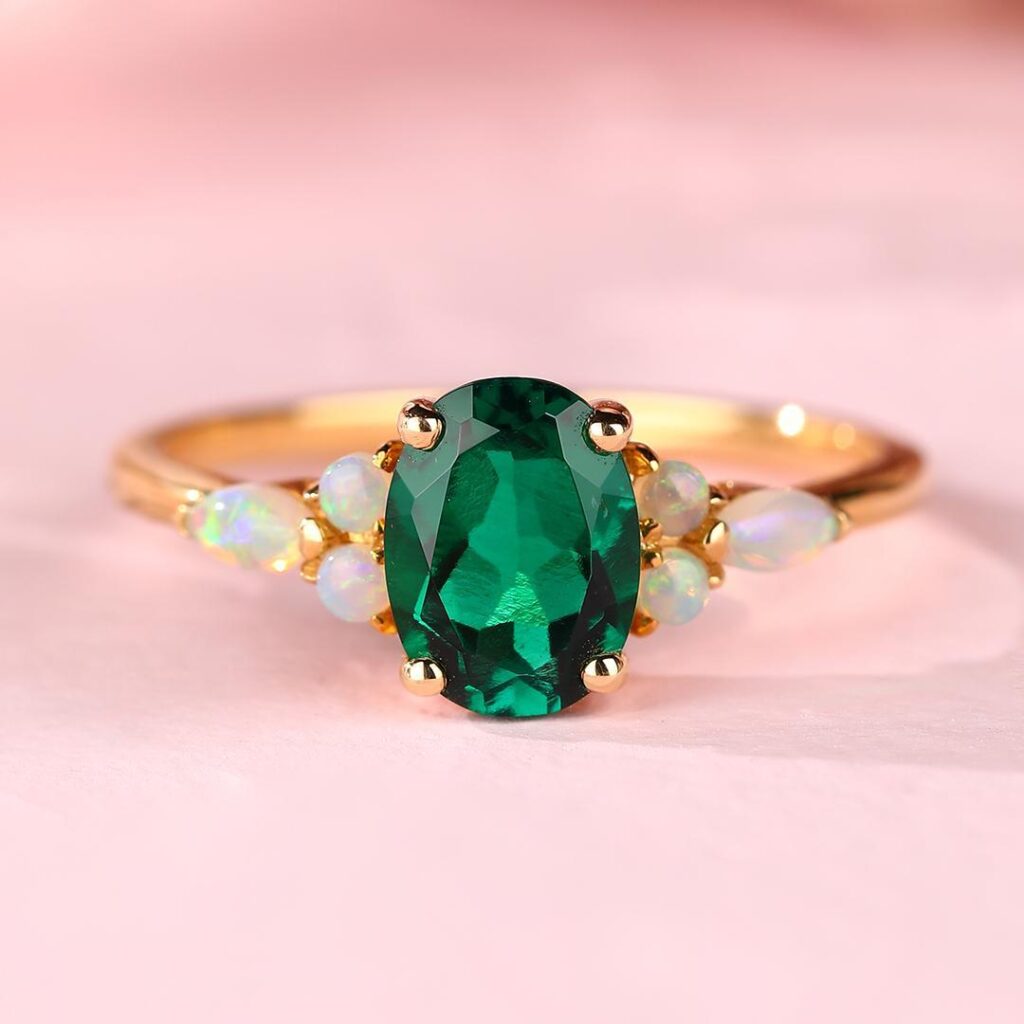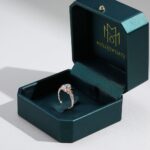Few gemstones capture the imagination like the emerald. More than just a beautiful stone, Emerald Jewelry carries a weight of history and a depth of symbolism that has fascinated mankind for millennia. Join us as we delve into the captivating story behind emerald jewelry, exploring its origins, myriad meanings, and timeless appeal that continues to enchant us today.
Understanding Emerald: Nature’s Green Miracle
Emeralds, with their hypnotic green hues, have fascinated mankind for millennia. To fully understand their allure, we must first unravel their scientific essence and geographic origins.
What Is Emerald?
Emerald is a variety of the mineral beryl (Be₃Al₂Si₆O₁₈). Unlike other beryl varieties such as aquamarine (blue) or morganite (pink), emeralds owe their iconic hue to these specific impurities interacting with light during crystal formation.
Emerald has a hardness of 7.5 to 8 on the Mohs scale, making it relatively durable. However, it often contains natural inclusions and fractures, sometimes called “jardin” (French for “garden”), which can affect its toughness (resistance to breaking).
Emeralds are also the birthstone for May and are traditionally given on 20th and 35th wedding anniversaries.
Where are Emeralds Found?
Emeralds are found in various locations around the world, with the most important sources being Colombia, known for its high-quality stones; Zambia, known for its bluish-green emeralds; and Brazil, which produces a wide range of greens. Other notable countries where emeralds are mined include Zimbabwe, Afghanistan, Pakistan, Russia, and Madagascar.
History Behind Emerald Jewelry
PattiRing Emerald Bridal Sets
Emeralds have been coveted for over 5,000 years, their legacy woven into the rise and fall of empires. Ancient Egyptians, who believed the gemstone symbolized eternal life, mined emeralds as early as 1500 B.C. Cleopatra famously claimed the Sikait mines as her own and used the stones in royal jewelry and diplomatic gifts.
Beyond Egypt, cultures such as those of ancient India and the Incas also treasured emeralds, incorporating them into their own symbols of wealth, power, and religious ceremonies. Centuries later, the discovery of rich emerald deposits in Colombia greatly influenced the global trade and availability of these gems.
During the Renaissance, emeralds became a status symbol among European royalty. Spain’s Habsburg rulers displayed Colombian emeralds in elaborate crown jewels, while Mughal emperors in India engraved them with Persian poetry.
In the 20th century, emeralds transitioned from aristocratic exclusivity to Hollywood glamour, epitomized by Elizabeth Taylor’s Bulgari suit – a gift from Richard Burton that became synonymous with both opulence and tumultuous love. Today, emeralds continue to captivate, bridging ancient mysticism and modern luxury.
Symbolism Behind Emerald Jewelry
PattiRing Emerald Engagement Rings
The emerald’s symbolism is as rich and complex as its color. Its most immediate relationship is with the color green, which represents spring, new growth, and nature’s bright pulse. This link imbues the emerald with strong symbolism:
Nature & Renewal
The emerald, like the soil rising after winter, symbolizes hope, new beginnings, and the endless circle of life. Emeralds’ brilliant green color symbolizes spring, growth, and fresh beginnings. Today, they are recognized as a symbol of hope and environmental concern.
Love & Luck
Emeralds, dubbed the “stone of Venus,” have long been connected with love, loyalty, and good fortune. Many cultures believed that they might strengthen relationships and promote peace. According to legend, if a partner was disloyal, an emerald would change color or even shatter, transforming it into a “stone of truth” in romantic relationships. It is still a popular choice for distinctive engagement rings and anniversary gifts (particularly for the 20th and 35th anniversaries).
Wisdom & Truth
Emeralds were frequently associated with prophetic powers in ancient folklore. A look into its depths was said to grant foresight, expose hidden truths, and keep the wearer safe from trickery and enchantment. It was regarded as a stone that sharpened the brain and increased the clarity of thought.
Hope & Healing
Emeralds have long been associated with physical and emotional healing. They were believed to soothe tired eyes, calm troubled minds, promote balance, and offer protection during travel or childbirth. Their soothing green hue was thought to relieve stress and bring harmony.
Royalty, Wealth, and Status
Emeralds have long been associated with tremendous riches, power, and aristocratic ancestry, from Cleopatra’s mines to the Spanish galleons carrying Colombian treasures. Owning substantial emerald jewelry was and continues to be a clear statement of great status and sophisticated taste.
Beyond symbolism, emerald pieces often retain high market value. For those exploring jewelry resale options, certified buyers can help ensure secure, transparent, and fair transactions.
How to Style Your Emerald Jewelry
Emerald Wedding Ring Sets from pattiring.com
Styling PattiRing’s emerald jewelry is a great way to add elegance, color, and sophistication to any look. Whether you’re dressing up for a special occasion or adding flair to your everyday look, here’s how to wear these magnificent jewels with confidence.
Minimalist Touch: A dainty emerald pendant or stud earrings look well with white shirts, jeans, or neutral tones.
Stackable Rings: Combine emerald rings with gold or silver bands to create a stylish, layered effect.
Office-ready: A simple emerald bracelet or little emerald-accented hoop earrings elevate professional clothing without being overpowering.
Cocktail Rings: A huge emerald ring lends instant sparkle to evening gowns, ideal for weddings or galas.
Conclusion
From ancient royalty to modern elegance, emerald jewelry has a timeless charm rooted in history and symbolic meaning. If you want to add a bit of this enthralling legacy to your own collection, check out the stunning and responsibly sourced emerald designs on PattiRing!






